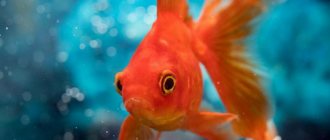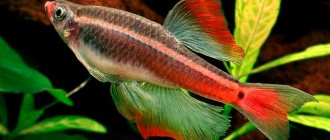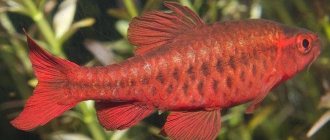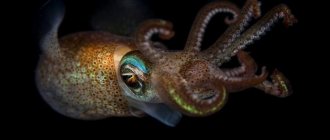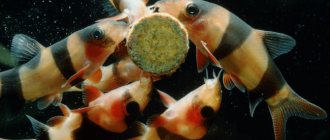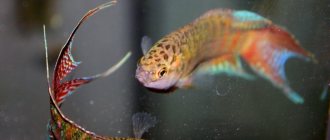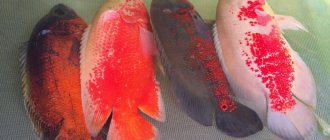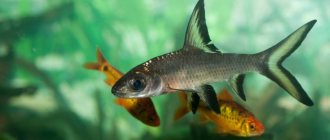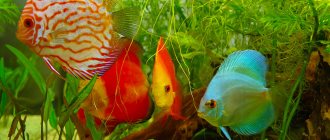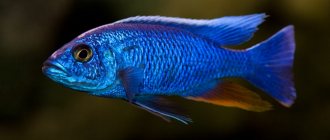Habitat in nature
Like the goldfish, the comet is an artificially bred breed and is not found in nature.
According to the main version, it appeared in the USA. It was created by Hugo Mulertt, a government official, in the late 1880s. Comet was successfully introduced into Government Fish Commission ponds in Washington County.
Later, Mullert began to actively promote goldfish in the United States and wrote several books about keeping and breeding these fish. It was thanks to him that this fish became popular and widespread.
But there is also an alternative version. According to her, this fish was bred by the Japanese, and Mullert created the American type, which later became widespread. However, the Japanese themselves do not claim to be the creators of the breed.
Comet
Comet is one of the fish included in the so-called “Goldfish” family. The fish is unusual and very beautiful. The comet's body is elongated with a long forked tail fin. The higher the assessment of a fish specimen, the longer its caudal fin.
The comet's color varies. Of particular value are individuals whose body color is different from the color of their fins. The main color of the body is red-orange with the occasional presence of white and yellow. The color of the fish is affected by the degree of lighting in the aquarium and the food. The length of the fish is up to 18 cm, life expectancy is about 14 years.
It is interesting to know that goldfish were bred in China more than 1,500 years ago, where they were bred in ponds and garden ponds on the estates of the nobility and wealthy people. Goldfish were first imported into Russia in the middle of the 18th century. It is interesting to know that in China, and in many other countries, the common name for all goldfish is “Jiyu”. So “goldfish” is just our associative Slavic and everyday name for this family of fish.
Currently, many breeds of goldfish are common and all of them are descendants of silver crucian carp . The full scientific name of the goldfish ancestor was CHINESE SILVER CRUCCIAN, but in Latin it was Carassius auratus japonicus. That is, JAPANESE GOLDEN CRUCCIAN. Such a damn verbal confusion =) Crucian carp was a silver Chinese subspecies, and they called it Japanese gold. Now, a new name for the goldfish has been legalized - Carrassius gibelio forma auratus. This name eliminates confusion. You certainly shouldn’t confuse the ancestor of scrofula with our Russian “golden crucian carp” (Carassius carassius) - which has nothing to do with goldfish at all.
So, silver crucian carp turned out to be an excellent object for breeding work. As a result of long-term selection in China, Korea and Japan, several hundred breeds of this ornamental fish have been developed. In the domesticated state, they lost the mobility characteristic of their wild ancestor; the body of most breeds became shorter and wider. The length and shape of the fins have changed. Some breeds lack dorsal fins, while others have altered size and position of the eyes. There are fish with various growths on the head, with transparent scales. The variety of colors is especially great. There are several color variations: red, silver, black and others. The most varied combinations and changes of these characteristics give an extraordinary variety of forms.
With that said, it would be correct to say that there are no “species of goldfish” - they are all breeds and fixed mutations within the same species (like dogs). We kindly ask all readers to be literate and convey this information to others. There are big differences between species, breeds and hybrids. A species is a single original individual. Breeds are selectively (artificially) fixed mutations within a species. But simply mutations within a species (natural - in themselves) are subspecies. Hybrids are mutations resulting from crossing different species or morphs of species (for example, a swordtail with a platie).
There is a legend version that all the genetic deformities of crucian carp (growths on the head, double tails, lack of a dorsal fin, etc.) were initially fixed unintentionally (by selection), but for religious reasons. Almost all goldfish breeders in the 7th and 8th centuries were Buddhists. Buddhism does not allow killing animals. Therefore, all the freaks from inbreeding were not destroyed, but settled in special “ponds of mercy” - where all these mutations, as a result, were fixed genetically on their own (the freaks multiplied in these ponds).”
Actually, here is a video clip on the topic discussed, which visualizes the essence of the problem.
These fish are not very picky about their living conditions. For maintenance you need a spacious aquarium with clean water - without nitrogen compounds. Neighbors should not be active and especially aggressive fish - barbs, cichlids, gourami, etc. You need to keep comets in an aquarium with a volume of at least 50 liters per individual, it is better if it is an aquarium of at least 100 liters, in which a couple of fish will be placed. Comfortable water parameters: temperature 20-25 C, aquarium water hardness 6-18, pH 5.0-8.0. Enhanced aeration and filtration.
The most important thing is that there are no excessive concentrations of nitrogen compounds and phosphates . This is the main problem for goldfish that beginners make. Ammonia, nitrite, nitrate, phosphates are the root cause of illness and death in pets. Every conscientious aquarist should always have a set of drop tests on hand, at least for nitrate and phosphate. Fortunately, they have now become inexpensive, there are no problems with their assortment and acquisition. For example, we can with a clear conscience recommend you the cool UHE drop tests, , but they are sold only online. In stores in your city - offline, you can find inexpensive Vladox tests .
When changing water, it would be useful to use clean water supply and use preparations that neutralize harmful substances. For example, Tetra AquaSafe - it removes chlorine compounds, heavy metals + contains B vitamins, iodine and other aquarium goodies. Those. With it, you can safely pour water into the aquarium without fear of harming your beloved pets.
Let us note one more, very important detail related to the maintenance of goldfish. It is problematic to keep gold with live aquarium plants. They, like locusts, mow down virtually any vegetation. If you still want to see green accents in an aquarium with goldfish, there are two options for solving the problem.
The first is to use plastic aquarium plants . For example, often in pet stores, you can be surprised by plants from the Laguna company, which are perfect for decorating an aquarium with goldfish.
The second option is to use large oak, rigid-leaved aquarium plants: anubias , cryptocorynes , echinodorus . However, keep in mind that over time, goldfish are capable of chewing even the most reinforced concrete Anubias to the very root. This is due to their gastronomic preferences, which we continue our story about below.
Feeding goldfish
Particular attention should be paid to the diet of goldfish. It is very important! Please do not feed them all kinds of bloodworms, worms, all kinds of homemade minced meat with rolled oats, etc. Goldfish are phytophages. Their digestive tract is very long, it is not able to properly digest protein foods. Which in turn provokes problems with the gastrointestinal tract: inflammation, internal bacterial infection. The latter are extremely difficult to treat. Their diet should consist of 70% plant foods, 30% protein.
Goldfish food
In our opinion, the best food for goldfish is duckweed + branded specialized food. But the problem is that even two young goldfish will gobble up duckweed in no time. A separate aquarium or vessel is needed to grow it in large quantities. Which you yourself understand is difficult and troublesome.
The way out of the situation could be food from our table - lettuce, spinach. But goldfish eat them less willingly; the lettuce hangs out in the aquarium for a long time and, for obvious reasons, it’s not worth keeping it like that.
It is most ergonomic to use specialized food for goldfish. For example, use food from the Tetra GoldFish series. Please note that they are all different - focusing on different ingredients. We would generally recommend making a mix - using TetraGoldfish Granules as a base food and TetraPhyll Granules as an additional plant food. The thing is that TetraPhyll is 100% plant food. And by alternating these foods, you will provide your pets with 100-500 percent balanced nutrition.
The feeding regime of goldfish also has its own peculiarities. Most aquarium tropical fish can easily be fed once a day. It is better to feed gold more often 2-3 times a day, but in small portions. Again, this recommendation depends on the specifics of the digestive system of these fish.
Comets reproduce independently, without any hormonal injections or without creating too specific conditions. Actual, good maintenance and proper feeding are the criterion and incentive for spawning of the spawners. All types of goldfish can spawn in small aquariums of 30 liters or more. However, better results can be achieved in larger aquariums or ponds. A detailed article about breeding comets is here .
Description
The main difference between a comet and a goldfish is the tail fin. It is single, forked (fork) and long. Sometimes the length of the caudal fin exceeds the length of the fish’s body.
The most common body color is yellow or golden, but there are red, white and white-red fish. The red color is most often found on the caudal and dorsal fin.
Body size up to 20 cm, but usually they are slightly smaller. Life expectancy is about 15 years, but under good conditions they can live longer.
How to distinguish a male from a female?
In comets, males and females look different. They are easy to distinguish by a number of external signs.
Features of females:
- more active;
- larger;
- have a brighter color;
- sharp fins on the belly;
- The belly becomes rounded and swollen during spawning.
Features of males:
- have rounded and shorter fins on the belly;
- the harder area between the belly and anus;
- growth in the back of the abdomen;
- concave anal opening;
- During spawning, the body shape remains elongated and flattened, and white stripes appear near the gills.
Content complexity
One of the most unpretentious goldfish. They are so unpretentious that they are most often kept in outdoor ponds along with KOI carp.
However, keeping it in a home aquarium has its limitations. First of all, comets need a spacious, large aquarium. Don’t forget that they grow up to 20 cm, and also swim actively and briskly.
In addition, these fish feel better in cool water, and when kept with tropical fish, their life expectancy is significantly reduced. This is due to the fact that metabolic processes occur faster in warmer water.
In this regard, it is recommended to keep them in species aquariums with similar fish.
Breeding
Breeding comets at home is possible. To do this, it is necessary to prepare a separate spawning tank. Its volume must be at least 40 ml. A net is placed on the bottom of the aquarium and special small leafy plants are planted. The spawning tank must have a high-quality filter. A female and 2-3 males are placed for breeding.
Differences between a female and a male
In comets there are no pronounced differences between males and females. It is necessary to carefully monitor representatives of the species at sexual maturity, which occurs closer to 2 years. During this period, females become round due to their eggs. Males actively chase them, leaning against the ovipositor. In mature males, characteristic warty outgrowths can be seen outside the gill covers.
Spawning
Spawning begins in comets closer to spring. It is recommended to place the female and several males in the spawning tank in advance so that they spend at least several weeks together. It is worth increasing the water temperature in the spawning tank to 28-30°C. This is a spawning stimulating factor. At the same time, the duration of daylight hours is increased to 10-12 hours.
One female lays 7-10 thousand eggs. After successful spawning, males must be removed. The eggs develop in approximately 3 days. As the fry grow older, they can be gradually transferred to ready-made dry food.
Keeping in an aquarium
The main content issues are described above. In general, they are very unpretentious fish, capable of living in completely different conditions.
For those who encounter these fish for the first time, it may come as a surprise how large they can be. Even those who understand goldfish often think that they are looking at pond KOIs, not comets.
Because of this, they need to be kept in the most spacious aquariums, despite the fact that adolescents are capable of living in small spaces. The minimum volume for a small flock is from 400 liters. Optimal - 800 or more. This volume will allow the fish to reach their maximum body and fin size.
When it comes to choosing a filter for gold, a simple rule works - the more powerful, the better. It is best to use a powerful external filter, such as the FX-6, charged with mechanical filtration.
Comets are active, eat a lot and love to burrow in the soil. This leads to the fact that the water quickly deteriorates, ammonia and nitrates accumulate in it.
These are cold-water fish and in winter it is better to do without a heater. Moreover, they need to be kept in a cool room, and in the summer, maintain a lower temperature in it using an air conditioner.
The optimal water temperature is 18 °C.
Water hardness and pH do not matter much, but it is better to avoid extreme values.
Reproduction
Fish become sexually mature at two years of age. They learn about the approaching spawning by the rounded belly of the female. In males, growths appear on the gill covers and pectoral fin.
Prepare a spawning tank for comets with a volume of 30–40 liters. The bottom is left uncovered or a separate mesh is placed. Provide aeration and 12-hour lighting.
06:38
COMET. MAINTENANCE, FEEDING AND BREEDING.
A pair or one female and two males are placed in the spawning tank. Select sires of appropriate sizes with appearance that meets breed standards. The female, ready for spawning, secretes an odorous substance that induces males to engage in mating games.
2 weeks before leaving the common aquarium, comets are fed worms, daphnia, and bloodworms. To stimulate reproduction, increase the water temperature by 2 degrees.
The male helps the female by chasing her around the aquarium. Spawning usually begins at dawn and lasts 6 hours. The eggs released in parts are immediately fertilized and sink to the bottom. The female comet lays only 1–3 thousand eggs, after which the parents are removed to prevent the future offspring from being eaten. Reduce the water level to 10 cm.
Comets are capable of reproducing monthly all year round. But frequent spawning weakens the health of fish.
The baby comets soon look like their parents.
By the third day, the characteristic orange color of the eggs becomes discolored. The fry appear on days 5–8. After three days, when they are freely swimming around the aquarium, and not moving jerkily, as in the first days, they begin to feed. The fry's diet consists of live dust, crushed yolk, and oatmeal.
Feeding
Feeding is not difficult; it is an omnivorous fish that eats all types of live, artificial and plant foods. However, feeding has its own nuances.
Goldfish's ancestors ate plant foods, with animals representing a relatively small percentage of their diet. Neglect of this rule leads to sad consequences similar to intestinal volvulus.
A lack of plant fiber in the diet leads to the fact that protein feed begins to irritate the fish’s gastrointestinal tract, inflammation and bloating appear, the fish suffers and dies.
Bloodworms are especially dangerous because they have low nutritional value; fish cannot get enough of them and overeat.
Vegetables and food with spirulina will help cope with the problem. Vegetables include cucumbers, zucchini, squash and other soft varieties. You can give young nettles and other non-bitter plants.
Vegetables and herbs are first doused with boiling water, then immersed in water. Since they don’t want to drown, the pieces can be placed on a stainless steel fork.
It is important not to keep them in water for too long, as they quickly decompose and spoil the water.
Reviews
Comets are considered interesting fish to watch. Aquarists do not regret purchasing this elegant fish for their aquarium, because caring for them is simple and reproduction does not require special knowledge.
Compatibility
Comets are cold-water fish, so it is not recommended to keep them with tropical species. In addition, their long fins can become a target for fish that like to tug on their neighbors' fins. For example, Sumatran barb or ternetia.
It is ideal to keep them separately from other species or with goldfish. And even among the gold ones, not everyone will suit them.
For example, oranda needs warmer water. Goldfish and Shubunkin will be good neighbors.
Diseases
Comets are considered relatively hardy fish. But if there are violations in care and feeding, certain diseases can develop:
- semolina: the body of the fish is covered with white dots that look like a scattering of semolina;
- fin rot: fins stick to each other, and representatives of the species themselves lose physical activity and begin to eat poorly;
- dermatomycosis: a characteristic white coating appears on the body of the fish;
- ascites: the disease is manifested by refusal to eat, characteristic bulging of the eyes and the appearance of lesions and ulcerative defects on the body of the fish.
Sick individuals refuse to eat. Specific medications must be used for treatment. They contain antibiotics and antifungal components. Infected fish must be placed in a special separate tank with high-quality aeration and filtration.
Ascites
The fish's scales become ruffled, its belly enlarges, and bulging eyes develop. Sores appear on the body, activity decreases. The disease is treatable only at the initial stage.
The fish is removed, 1 tsp is added to 40 liters of water. Epsom salt, which draws out excess liquid. Baths of a pale pink solution of potassium permanganate help. The sick comet is launched into the container for 10 minutes, then placed back into the depositor.
Ichthyophthiriasis
The fungal infection is also called semolina because of the white pustules resembling semolina scattered over the body and fins.
The disease is treated by gradually raising the temperature to 30°C, adding salt (1 tbsp per 10 liters of water). Comets are treated in a community aquarium with malachite green (0.1 mg per 1 l), iodine (10 drops per 50 l), furazolidone (150 mg per 50 l). The last drug is toxic to plants, be careful!
Fin rot
A serious illness that often ends in the death of the pet. A pale blue mucous coating covers the fins, then the infection spreads to the body, covering the fish's skin with ulcers. The comet is placed in a separate container. Along with the daily water change, Levomycetin (0.5 tablets per 10 l), Bicillin-5 (a tenth of a bottle per 10 l) or streptocide (15 g per 100 l) are added to the aquarium.
